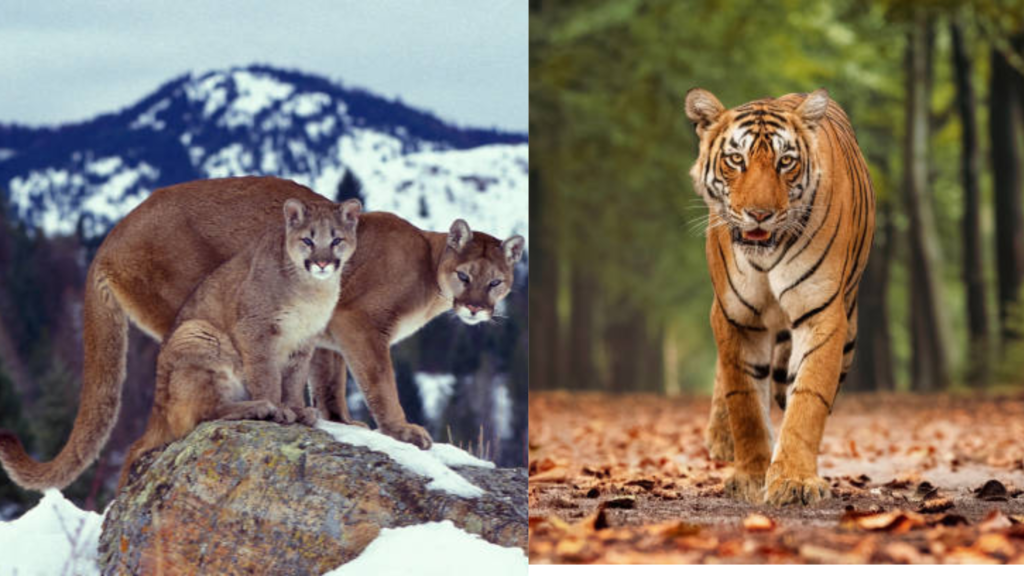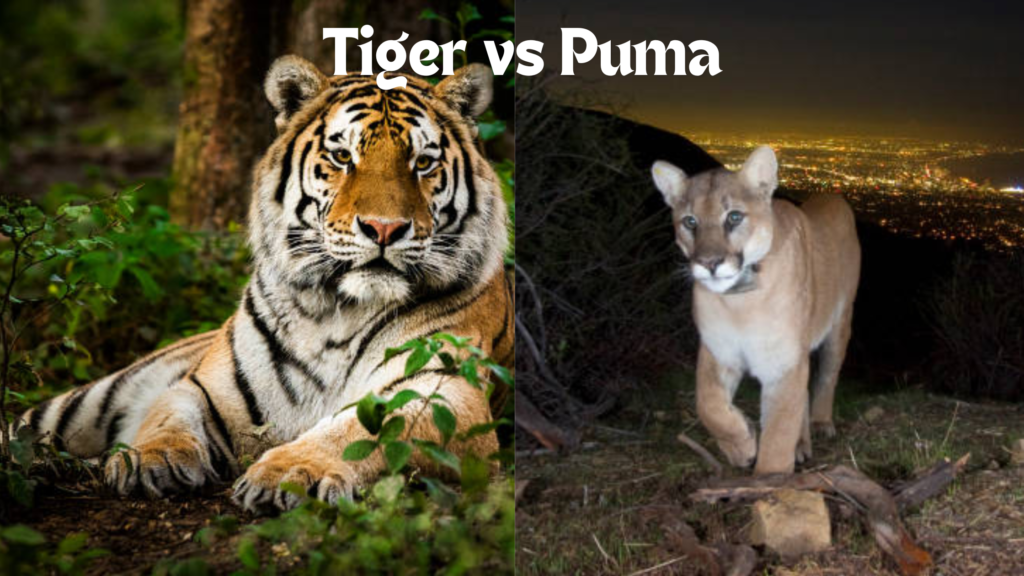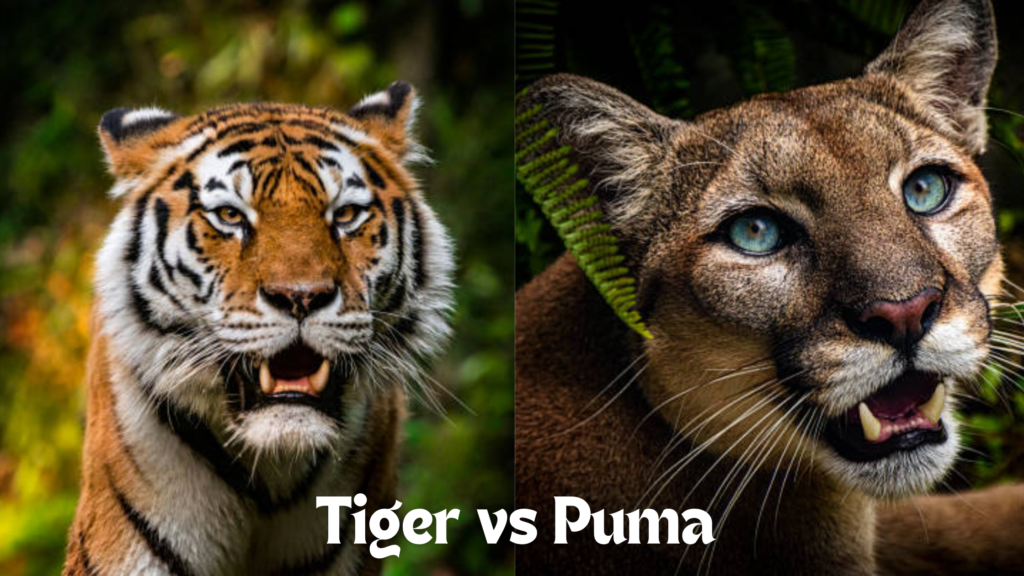Introduction
Pumas and tigers are the most charming and majestic big cats in the animal kingdom. Both species have specific traits, behaviors, and habitats, leading to exciting study topics. This article reviews pumas vs tigers, evaluating and contrasting these incredible creatures in diverse elements.
Classification and physical traits of Pumas vs Tigers
Pumas
Pumas, also called cougars, mountain lions, or panthers, belong to the species Puma concolor. They may be native to the Americas and are enormously adaptable, thriving in diverse habitats, from forests and mountains to deserts and swamps. Pumas are the fourth largest big cat species, with men commonly weighing between one hundred fifteen to 220 kilos and females starting from sixty-four to a hundred and forty kilos. They have a slim, muscular build with a tawny coat, a lighter underbelly, and a one-of-a-kind black-tipped tail.
Tigers
Tigers, labeled underneath the species Panthera tigris, are the most important of the massive cats and are local to Asia. Using their effective construct, they may be characterized by an orange coat with black stripes and a white underbelly. Tigers are divided into several subspecies, including the Bengal tiger, Siberian tiger, Sumatran tiger, and others, and they are all adapted to particular environments. Male tigers typically weigh between 220 to 660 pounds, at the same time as females, which range from 165 to 370 pounds, with the Siberian tiger being the most giant subspecies.
Habitat and Distribution Pumas vs Tigers
Pumas
Pumas have the most extensive range of wild terrestrial mammals within the Western Hemisphere, from the Canadian Yukon to the southern Andes in the South United States. They decide upon habitats with dense underbrush and rocky regions for stalking prey; however, they are enormously adaptable and can also be observed in open areas or even on the outskirts of urban environments.
Tigers
Tigers are ordinarily located in isolated pockets across Asia, drastically reducing their range because of habitat loss and poaching. They inhabit many environments, such as tropical forests, mangrove swamps, grasslands, and temperate forests. Every subspecies of the tiger has adapted to its specific habitat, with the Siberian tiger enduring harsh winters in the Russian ways East and the Bengal tiger thriving in the Sundarbans’ mangrove forests.

Conduct and Social shape Pumas vs Tigers
Pumas
Pumas are solitary animals, except for moms and their cubs. They are distinctly territorial, with adult males keeping massive territories overlapping numerous women’s smaller territories. Pumas are crepuscular, which means they’re maximum active throughout dawn and nightfall. They’re ambush predators, counting on stealth and the detail of marvel to seize their prey, which includes deer, elk, and smaller mammals.
Tigers
Tigers are also solitary and territorial animals. Male tigers have larger territories that may overlap with the territories of several women, but they may be typically intolerant of different adult males. Tigers are often nocturnal hunters, using their keen sense of smell and vision to track and ambush prey. Their food regimen consists mainly of large ungulates, such as deer, wild boar, and buffalo, but they’re additionally recognized to seek smaller animals and, on occasion, cattle.
Hunting Strategies and Diet Pumas vs Tigers
Pumas
Pumas are skilled hunters, employing a mixture of stealth, electricity, and pace. They usually stalk their prey from a distance, using cover to get as near as possible before launching a quick assault. Pumas often goal the neck or throat of their prey with an effective chew, killing it quickly. Their food regimen varies depending on their habitat but commonly includes deer, elk, different ungulates, and smaller mammals like rabbits and rodents. Pumas might also hunt cattle in regions with much less prey availability, leading to conflicts with humans.
Tigers
Tigers are apex predators with bold hunting abilities. They rely upon their power, stealth, and powerful jaws to take down prey. Tigers typically ambush their prey, drawing close silently and then pouncing with a burst of pace. They use their strong forelimbs to comprehend the prey and supply a fatal chew to the neck or throat. Tigers often feed on large ungulates with deer, wild boar, and buffalo, but their eating regimen includes smaller animals, fish, and carrion. Tigers may also prey on farm animals in some regions due to human flora and fauna conflicts.
Reproduction and Lifespan Pumas vs Tigers
Pumas
Pumas have an exceptionally long reproductive cycle, with ladies giving beginning to litters of 1 to six cubs after a gestation length of approximately 90-96 days. They start eating solid food at around six weeks and stay with their mom for the first few months. They begin to eat strong food at around six weeks and remain with their mother for up to 2 years, gaining knowledge of critical survival competencies before dispersing to establish their territories. Pumas can live up to 12 years in the wild and up to 20 years in captivity.
Tigers
Tigers have a gestation period of around 93-112 days, and then females supply start to litters of 6 cubs. They begin ingesting meat at around six to eight weeks and continue to be with their mom for approximately years, getting to know and seek and continue to exist. Tigers attain sexual adulthood at around 3 to 4 years old. In the wild, tigers have a lifespan of 10-15 years; in captivity, they can stay up to twenty-25 years.

Conservation Popularity and Threats Pumas vs Tigers
Pumas
Pumas are currently categorized as a species of “Least subject” by the Global Union for Conservation of Nature (IUCN). But, they face huge threats, habitat loss, human-natural world conflicts, and looking. In some areas, pumas are searched for fur or as trophies; in others, they’re killed to shield farm animals. Conservation efforts recognize maintaining habitats, reducing human-wildlife conflicts, and implementing felony protections to ensure their survival.
Tigers
With some subspecies indexed as “significantly Endangered.” the worldwide tiger populace has declined dramatically due to, poaching for fur and body components, and human-wildlife conflicts. Conservation efforts include habitat upkeep, anti-poaching measures, captive breeding programs, and network engagement to sell coexistence. Global cooperation and stricter enforcement of flora and fauna safety laws are essential for the survival of tigers.
Cultural importance Pumas vs Tigers
Pumas
Pumas hold sizable cultural and symbolic costs in various indigenous cultures across the Americas. They’re frequently respected as powerful and mystical animals, representing energy, courage, and guardianship. In modern times, pumas have become iconic symbols of barren regions and the herbal global, featuring prominently in literature, artwork, and sports team mascots.
Tigers
Tigers have a profound cultural and religious importance in many Asian cultures. They are frequently associated with power, bravery, and royalty. In Hindu mythology, the tiger is the automobile of the goddess Durga, symbolizing her electricity and ferocity. Tigers also function prominently in Chinese folklore and are one of the twelve zodiac animals. They’re depicted in art, literature, and as countrywide symbols, embodying the spirit of the wild and the fight for conservation.
Variations in diversification Pumas vs Tigers
Pumas
Pumas show off superb adaptability, letting them thrive in a wide variety of environments. Their slim, muscular build and lengthy limbs permit them to navigate various terrains with agility and speed. Pumas have brilliant mountain climbing competencies, which help them avoid predators and hunt from elevated positions—their keen eyesight and listening aid in detecting prey and keeping off risk. Pumas’ capacity to regulate their weight loss plan is primarily based on prey availability, which enhances their survival in numerous habitats.
Tigers
Tigers are tremendously specialized predators with diversifications that healthy their specific environments. Their effective build and strong forelimbs make them adept at killing massive prey. The unique stripes on their coat offer excellent camouflage within the dappled mild of forests, aiding in stealth all through hunts. Tigers have webbed feet, which help them swim, making them proficient hunters in water-rich habitats. Their acute experience of scent and night vision beautify their looking performance, permitting them to thrive in various ecosystems.
Human Interactions and Conflict Pumas vs Tigers
Pumas
Human interactions with pumas regularly bring about conflicts, ordinarily due to habitat encroachment and farm animal predation. As human populations expand into puma territories, encounters become more frequent, leading to destructive perceptions and retaliatory killings—conservationists plan to mitigate those conflicts via training, non-dead deterrents, and promoting coexistence techniques. Creating wildlife corridors and shielding herbal habitats are essential to lowering human-puma conflicts and ensuring survival.
Tigers
Tigers face considerable threats from human sports, including habitat destruction, poaching, and conflicts with neighborhood groups. Human-tiger conflicts often arise when tigers prey on farm animals or encroach on human settlements for food. Conservation groups collaborate with local communities to put in force measures consisting of livestock safety, relocation of problem tigers, and network-primarily based conservation packages. Raising focus on the significance of tigers and their position in ecosystems is crucial for fostering coexistence and lowering conflicts.

Conservation Efforts Pumas vs Tigers
Pumas
Conservation efforts for pumas recognition on habitat upkeep, decreasing human-flora and fauna conflicts, and enforcing felony protections. Flora and fauna corridors and protected areas are established to ensure connectivity and secure passage for pumas. Community outreach and training packages promote coexistence and reduce negative perceptions of pumas. Research on puma conduct, ecology, and populace dynamics provides precious insights for powerful conservation techniques.
Tigers
Tiger conservation initiatives involve habitat protection, anti-poaching efforts, and network engagement. Organizing and preserving protected regions and flora and fauna corridors are vital for maintaining tiger habitats and ensuring genetic variety. Anti-poaching devices and strict enforcement of natural world safety laws purpose to fight illegal searching and exchange of tiger parts. Network-primarily based conservation applications, which include eco-tourism and sustainable livelihood initiatives, assist in reducing human-tiger conflicts and garner nearby support for tiger conservation.
Future Outlook
Pumas
The destiny of pumas relies upon endured conservation efforts, habitat upkeep, and fostering coexistence with human groups. As urbanization and habitat fragmentation increase, preserving wildlife corridors and guarded regions could be essential. Public recognition and schooling applications can help shift perceptions and promote coexistence. Collaborative efforts among governments, conservation agencies, and local groups are vital in ensuring the long-term survival of pumas.
Tigers
The future of tigers hinges on intensified conservation movements, global cooperation, and stringent enforcement of wildlife safety laws. Maintaining and restoring tiger habitats, combating poaching, and lowering human-tiger conflicts are critical. International focus campaigns and community involvement play pivotal roles in garnering a guide for tiger conservation. Persistent research and monitoring tiger populations provide valuable information for adaptive control techniques. The dedication of governments, conservationists, and the global network is crucial for securing a future for tigers in the wild.
Conclusion
Notwithstanding their variations, pumas and tigers proportion commonplace demanding situations and threats inside the current global. Their conservation requires a concerted attempt to defend habitats, mitigate human-natural world conflicts, and promote coexistence. Knowledge of these majestic massive cats’ particular characteristics, behaviors, and ecological roles is essential for their protection. By fostering a deep appreciation for pumas and tigers and imposing effective conservation techniques, we can ensure that these iconic animals continue to roam the wild landscapes they’ve inhabited for millennia.











